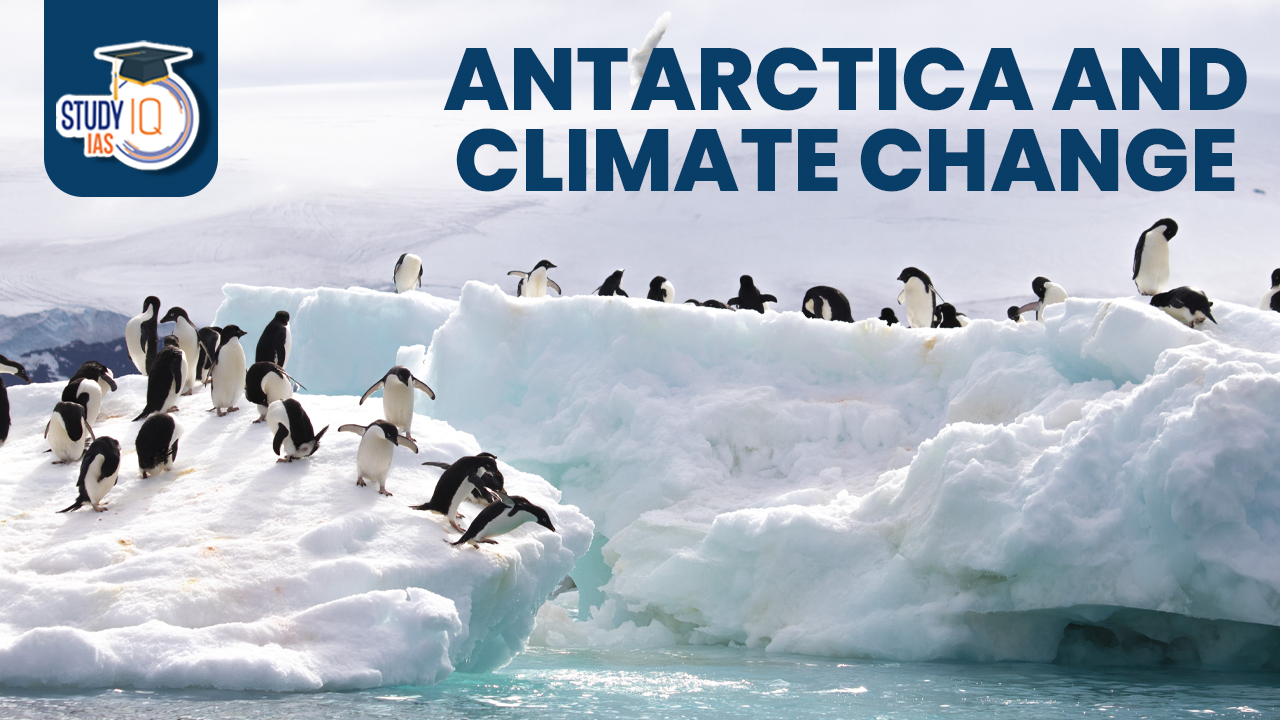Table of Contents
Context: In late 2022, four out of five emperor penguin colonies located in Antarctica’s Bellingshausen Sea region experienced total breeding failure due to sea ice loss caused by global warming.
About Emperor Penguin
- The emperor penguin is the tallest and heaviest of all living penguin species and is endemic to Antarctica.
- Like all penguins, it is flightless. It is the only penguin species that breeds during the Antarctic winter.
- The lifespan is typically 20 years in the wild, although observations suggest that some individuals may live to 50 years of age.
- IUCN status: Near threatened
About Antarctica
- Antarctica is Earth’s southernmost and the fifth-largest continent.
- It is mainly a polar desert and is covered mostly by the Antarctic ice sheet, with an average thickness of 1.9 km.
- The Antarctic covers approximately 20 percent of the Southern Hemisphere.
- About 70% of the world’s freshwater reserves are frozen in Antarctica, which, if melted, would raise global sea levels by almost 60 meters.
- Biodiversity: Native species of animals include mites, nematodes, penguins, seals and tardigrades. Where vegetation occurs, it is mostly in the form of lichen or moss.

- Significance of Antarctica:
- Global climate regulation: It helps regulate the global climate by driving atmospheric circulation and ocean currents, and absorbing heat and carbon dioxide.
- Limiting Global Warming: Antarctic ice deflects some of the sun’s rays away from the Earth, keeping temperatures tolerable.
- Climate indicator: The discovery of an ozone hole over Antarctica in 1985 revealed the damage man-made chemicals are doing to the Earth’s atmosphere.
- Sea level rise: Complete melting of the massive Antarctic ice sheet is projected to be unlikely, but even a small melt could raise global sea levels and cause flooding around the world.
- Governance of Antarctica: Antarctica is governed by about 30 countries, all of which are parties of the 1959 Antarctic Treaty System.
- According to the terms of the treaty, military activity, mining, nuclear explosions, and nuclear waste disposal are all prohibited in Antarctica.
- Tourism, fishing and research are the main human activities in and around Antarctica.
- Antarctic Treaty System: There are few related agreements that make up the Antarctic treaty system. They are as follows:
- The Protocol on Environmental Protection to the Antarctic Treaty (Madrid, 1991)
- The Convention for the Conservation of Antarctic Seals (CCAS, London, 1972)
- The Convention on the Conservation of Antarctic Marine Living Resources (CCAMLR, Canberra, 1980).
- India and Antarctica:
- India today has two operational research stations in Antarctica named Maitri (Commissioned in 1989) and Bharati (Commissioned in 2012).
- India has successfully launched 40 annual scientific expeditions to Antarctica till date.
- India became a party to the Antarctic Treaty in 1983.
- The Indian Antarctic Bill, 2022:
- The bill is in pursuant to India’s accession to Antarctic Treaty, the Protocol on Environment Protection (Madrid Protocol) to the Antarctic Treaty and to the Convention on the Conservation of Antarctic Marine Living Resources.
- The Bill aims at having India’s own national measures for protecting the Antarctic environment as also the dependent and associated ecosystem.
- The Bill also proposed to set-up Indian Antarctic Authority (IAA) under the Ministry of Earth Sciences, which shall be the apex decision making authority and shall facilitate programmes and activities permitted under the Bill.
Impacts of Climate Change on Antarctica
- Antarctic Warming: The mean annual air temperature of the Antarctic Peninsula has increased by nearly 3°C in the region in the last 50 years, five times the global mean.
- This phenomenon of warming in Antarctica at a higher rate than the global average is known as “Antarctic amplification.”
- This amplification is driven by various feedback mechanisms, such as changes in ice-albedo feedback (reflectivity of ice and snow) and shifts in atmospheric circulation patterns.
- Ice shelf degradation: Over a third of the Antarctic’s ice shelf area may be at risk of collapsing into the sea if global temperatures reach four degrees Celsius above pre-industrial levels, according to a study.
- According to NASA, Antarctica is losing ice mass (melting) at an average rate of about 150 billion tons per year, adding to sea level rise.
- In 2019, Antarctica lost 168 billion tonnes of ice – the sixth highest year on record – owing to the continued speedup of glaciers in West Antarctica and record melting from the Antarctic Peninsula.
Impacts of climate change on Antarctica’s biodiversity
- Habitat loss: As global warming worsens, Antarctica’s ice-free areas are predicted to expand, rapidly changing the habitat available for wildlife.
- Extreme events: As extreme weather events such as heatwaves become more frequent, Antarctica’s plants and animals are expected to suffer.
- Invasive species: Increasing tourism and research activities, and milder temperatures in Antarctica due to global warming also creates the conditions for invasive species to thrive.
- Colonization by plants: Melting of perennial snow and ice covers has resulted in increased colonization by plants. According to a study, the increase in plants since 2009 has been greater than the previous 50 years combined
- Pollution from Permafrost: Increasing temperatures in Antarctica also leads to melting of permafrost which can release many chemicals contaminants and nutrients, which in turn affects the water chemistry and wildlife in the region.
- Beneficial species: Climate change won’t lead to a decline in all Antarctic species – in fact, some may benefit initially. These include the two Antarctic plants, some mosses and the Gentoo penguin.
- These species may increase their populations and become more widely distributed in the event of more liquid water (as opposed to ice), more ice-free land and warmer temperatures.
Way forward
- Climate change mitigation: Reducing climate change to no more than 2 degrees Celsius of warming would benefit up to 68% of terrestrial species and breeding seabirds.
- Regional and global efforts: As Antarctica faces increasing pressure from climate change and human activities, a combination of regional and global conservation efforts is needed.
- Species protection: Measures such as granting special protections to species, and increasing biosecurity to prevent introductions of non-native species should be adopted.
- Funding: Spending just USD 23 million a year to preserve Antarctica’s biodiversity and ecosystems is an absolute bargain.


 Indian Army Day 2025, Theme, Date, Histo...
Indian Army Day 2025, Theme, Date, Histo...
 Indian Diaspora, History, Significance a...
Indian Diaspora, History, Significance a...
 What led to the Azerbaijan Airlines Jet ...
What led to the Azerbaijan Airlines Jet ...




















